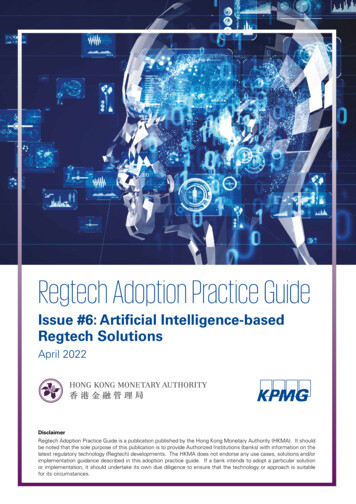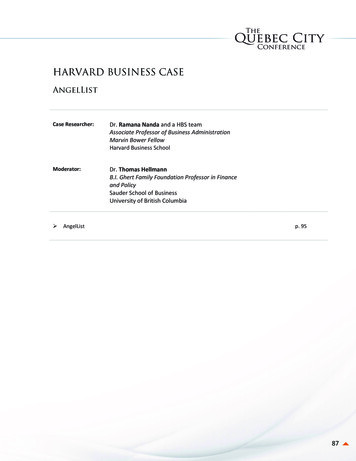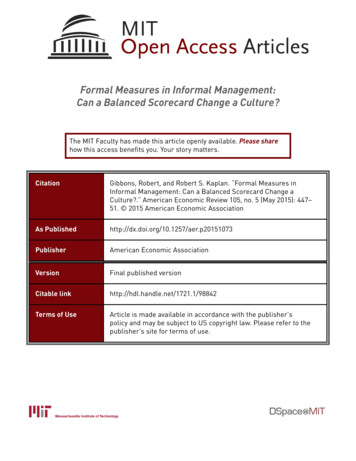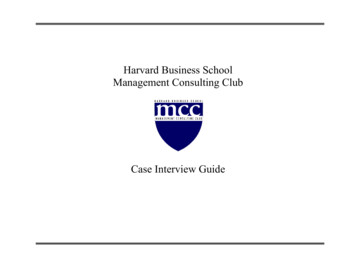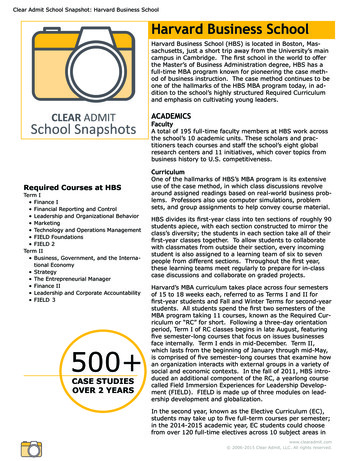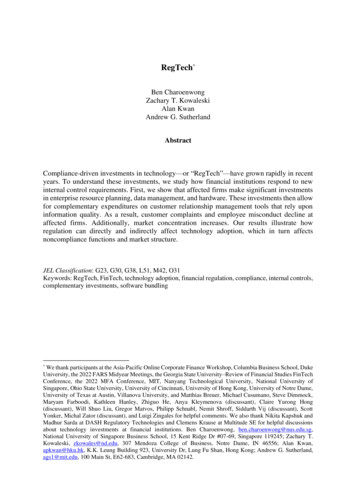
Transcription
RegTech*Ben CharoenwongZachary T. KowaleskiAlan KwanAndrew G. SutherlandAbstractCompliance-driven investments in technology—or “RegTech”—have grown rapidly in recentyears. To understand these investments, we study how financial institutions respond to newinternal control requirements. First, we show that affected firms make significant investmentsin enterprise resource planning, data management, and hardware. These investments then allowfor complementary expenditures on customer relationship management tools that rely uponinformation quality. As a result, customer complaints and employee misconduct decline ataffected firms. Additionally, market concentration increases. Our results illustrate howregulation can directly and indirectly affect technology adoption, which in turn affectsnoncompliance functions and market structure.JEL Classification: G23, G30, G38, L51, M42, O31Keywords: RegTech, FinTech, technology adoption, financial regulation, compliance, internal controls,complementary investments, software bundling*We thank participants at the Asia-Pacific Online Corporate Finance Workshop, Columbia Business School, DukeUniversity, the 2022 FARS Midyear Meetings, the Georgia State University–Review of Financial Studies FinTechConference, the 2022 MFA Conference, MIT, Nanyang Technological University, National University ofSingapore, Ohio State University, University of Cincinnati, University of Hong Kong, University of Notre Dame,University of Texas at Austin, Villanova University, and Matthias Breuer, Michael Cusumano, Steve Dimmock,Maryam Farboodi, Kathleen Hanley, Zhiguo He, Anya Kleymenova (discussant), Claire Yurong Hong(discussant), Will Shuo Liu, Gregor Matvos, Philipp Schnabl, Nemit Shroff, Siddarth Vij (discussant), ScottYonker, Michal Zator (discussant), and Luigi Zingales for helpful comments. We also thank Nikita Kapshuk andMadhur Sarda at DASH Regulatory Technologies and Clemens Krause at Multitude SE for helpful discussionsabout technology investments at financial institutions. Ben Charoenwong, ben.charoenwong@nus.edu.sg,National University of Singapore Business School, 15 Kent Ridge Dr #07-69, Singapore 119245; Zachary T.Kowaleski, zkowales@nd.edu, 307 Mendoza College of Business, Notre Dame, IN 46556; Alan Kwan,apkwan@hku.hk, K.K. Leung Building 923, University Dr, Lung Fu Shan, Hong Kong; Andrew G. Sutherland,ags1@mit.edu, 100 Main St, E62-683, Cambridge, MA 02142.
1. IntroductionIn their compliance efforts, financial institutions (FIs) are increasingly investing ininformation technology and hiring technological experts, a development industry participantsrefer to as “RegTech.” In 2019, public U.S. FIs spent nearly 10 billion on RegTechinvestments, compared to just 2.2 billion on auditing, and RegTech expenditures are forecastto grow at 35% per year (Juniper 2021). RegTech is one of the fastest-growing segments basedon global venture capital, private equity, and merger volume (Marlin & Associates 2021).RegTech investments commonly involve sweeping improvements in data collection,data management, and information systems. While regulators may intend for theseimprovements to enhance investor protection, FIs report also using RegTech investments intheir operations management and strategy (Thomson Reuters 2021). Additionally, interactionsbetween regulation, big data, and market power are attracting attention from researchers andpolicymakers concerned with the elevated concentration in the financial sector (Philippon2016).Despite growing interest in FinTech (D’Acunto, Prabhala, and Rossi 2019; Goldstein,Jiang, and Karolyi 2019), we lack evidence on firms’ RegTech investments and their effect onoperations and market structure. Few settings permit researchers to observe technologicalinvestments at individual firms. When data are available, studying technology adoption isinherently difficult: adoption decisions are typically endogenous, and, in cases where adoptionis driven by regulation, one must be able to observe both affected and unaffected firms.In this paper, we examine regulation adding new internal control requirements for asubset of U.S. broker-dealers (BDs) to investigate firms’ RegTech investment response, andexplore how these investments affect operations and market structure. To do so, we assemblea novel dataset covering multiple aspects of technological investment and operations at bothaffected and unaffected BDs. We track software and hardware investments using the Aberdeen1
Computer Intelligence Database (Bloom, Sadun, and Van Reenan 2012; Graetz and Michaels2018), website technology adoption data using BuiltWith (Koning, Hasan, and Chatterji 2019),and technology-related labor demand using Burning Glass Technologies (BGT) (Hershbeinand Kahn 2018; Acemoglu et al. 2020). For operations data, we examine customer complaintsand misconduct involving individual employees, publicly reported on the BrokerCheckwebsite. BDs with available data are responsible for the majority of the assets and employmentin the industry and include both publicly and privately held FIs.Our findings are threefold. First, the regulation had direct and indirect effects ontechnology adoption at affected BDs. These BDs increase their IT budgets, add enterpriseresource planning (ERP) and data management software that directly aids compliance with theamendment, and add servers and computers. They also increase job postings for computer andinformation systems managers. We then show regulation indirectly affects technology adoptionby requiring new data investments that can be leveraged for noncompliance purposes (e.g.,enables adoption of communications and customer relationship management [CRM] tools thatrequire high quality data). Second, as a result of these technological investments, affected BDssee fewer customer complaints and less employee misconduct. Third, labor marketconcentration increases.The regulatory changes we study followed the discovery of large Ponzi schemes in thelate 2000s, when the SEC sought to improve safeguards for BD custody of customer securitiesand funds. Accordingly, the 2014 amendments to Securities Exchange Act Rule 17a-5(henceforth Rule 17a-5 or “the amendment”) require certain BDs to report on their internalcontrols over compliance with rules concerning capitalization and separation of customer andfirm assets (Kowaleski et al. 2018). Specifically, BDs must maintain controls for anddocumentation demonstrating moment-to-moment compliance with requirements to holdadequate net capital and segregate customer assets. While the amendment mandates internal2
control attestation only for carrying BDs—those that maintain custody of customer assets—allBDs must publicly disclose financial statements, employee records, and complaint details,providing a control group for our analyses.Before the amendment, many carrying BDs used “systems and technology that havebeen built in-house many years ago and as a result, have found it difficult to provide reportlogic details and report parameters to their auditors for testing” (Deloitte 2015). After theamendment, carrying BDs began to “invest in shoring up technology or data architecture toalleviate data-related concerns, including rationalizing data sources and centralizing data intoa single data source [thus establishing] increased accuracy and completeness of source data”(EY 2019).Our first analyses explore the direct channel of technology adoption by describing thenature and extent of compliance-driven investments in the eight years around the amendment.We compare investments across carrying and noncarrying BDs, while controlling for BD andlocation-by-year fixed effects as well as employees’ tenure, registration status, complainthistory, and cubic controls for BD size. These controls account for time-invariant BD features,local economic conditions, and the BD’s scale, expertise, product offerings, and service quality.We find that, after the amendment, carrying BDs increased their IT budgets by 40%.They employed 28% more ERP programs, 17% more data management programs, 39% moreservers, and 21% more computers. We also find significant extensive margin expansion:carrying BDs were 13% (8%) more likely to add an ERP (data management) program for thefirst time. These extensive margin results are notable in their own right, as “implementing anERP system is a major undertaking,” consuming significant time and resources (CFO Magazine2022). Carrying BDs also increased job postings for computer and information systemsmanagers by over 14%.3
We find parallel investment trends across affected and unaffected BDs beforehand.Additionally, we conduct a variety of matching and subsample analyses to confirm that ourfindings are not driven by differences in BD size, product offerings, or changes in regulationunrelated to the amendment.Our second set of tests investigates the indirect channel of technology adoption bystudying complementary investment. This analysis is motivated by the idea that data andinformation systems are nonrivalrous goods: multiple corporate functions can simultaneouslyuse them without detracting from their compliance role (Jones and Tonetti 2020). Because ofthis nonrivalrous property, RegTech investments can increase the return on complementaryassets (Teece 1986; Brynjolfsson and Hitt 2000; Hughes and Morton 2006). To illustrate, byenhancing the monitoring environment, communication and document management tools canhelp BDs improve customer service and reduce misconduct. However, adopting these toolsrequires having adequate information quality and availability. From this perspective, RegTechinvestments can render the necessary expenditures on these input factors sunk.Consistent with this hypothesis, we find that carrying BDs increased the number ofcommunication and document management programs by 13% following the amendment. Infact, we find that vendors commonly bundled these software programs with the RegTechofferings studied in our first tests. In placebo tests, we find no increase for other softwareprograms less pertinent to the amendment, indicating our findings do not follow fromconfounding events driving technological investment of all types at carrying BDs. We alsoobserve nearly 30% increases in CRM and premium website technologies commonly linked tointernal analytics tools and data infrastructure.11As examples, ThreatMetrix provides real-time fraud detection and transaction security, Pardot automatesmarketing and sales engagement, and goMoxie allows live chat between the customer and BD.4
To understand the operational effects of these technological investments, our third setof tests examines customer complaints and employee misconduct after the amendment.Common incidents relate to unsuitable investment recommendations, excessive trading, andcommissions—grievances unrelated to the amendment itself but conceivably prevented bymonitoring via the BD’s internal information processes. At carrying BDs, the complaint(misconduct incident) likelihood declined by four (three) percentage points, and the number ofcomplaints (misconduct incidents) fell by 9% (9%). These effects are meaningful, comparedto regulatory and individual factors studied in the literature (Charoenwong, Kwan, and Umar2019; Egan, Matvos, and Seru 2019; Kowaleski, Sutherland, and Vetter 2020), and we find noevidence that they are driven by business model differences or other regulation.2Instrumental variable tests point to the complaint declines happening through thetechnological investments studied in our earlier analyses. In separate tests examining the onsetof COVID-19 as a natural experiment, we further establish a role for technology in improvingcustomer service. Intuitively, COVID-19 forced most BD employees to work remotely, andBDs with superior technology beforehand were better positioned to respond to customerconcerns amid the significant market turmoil and better able to monitor employees in this newwork environment. Comparing BDs in the same location-quarter, we find those with superiortechnology before the pandemic experienced fewer complaints during the pandemic.Despite potentially benefitting from complaint declines, the damages BDs avoided arequite modest—in the low six figures—compared to the standard ERP implementation costswhich can run into the millions (Momoh 2015). Additionally, before the amendment, carryingBDs faced customer pressure to strengthen controls in response to the late 2000s BD Ponzischemes and bankruptcies. Then the additional investment we document could be viewed as2More generally, we note that back office differences in carrying and noncarrying BDs have little to do with thecustomer complaints we study. Complaints involving individual advisers overwhelmingly relate to investmentadvice, and not to their firm’s custody or capitalization status.5
NPV-negative and beyond what BDs would have independently chosen, absent theamendment.3 Reinforcing this, many late adopters adding technology only after the amendmenthad no complaint or misconduct history and were small—for them, compliance costs wouldhave been onerous, with uncertain benefit to customers. Onerous compliance costs also raisequestions about the market structure consequences of RegTech, which we explore in our finaltests.RegTech can affect market concentration through the relative burden of compliancecosts and the differential benefits of additional data. SEC comment letters discuss how theamendment’s compliance costs have a sizable fixed component and how larger BDs can moreeasily bear them (SEC 2013). In terms of benefits, large FIs make greater use of hardinformation in their operations (Stein 2002). Additionally, with cross-selling and statisticalmodelling, gains from additional customer information can increase with firm size. As oneindustry report explains: “Greater scale enables firms to increase these relatively fixed[technological] investments, and returns on those investments can increase significantly whenthey support a larger number of advisors and assets under management” (Martin 2021).Consistent with this claim, we find that employees are 4% more likely to move fromunaffected to affected BDs following the amendment. Accordingly, labor market concentrationincreases. While the welfare effects of concentration are complex (Carlton 2007; Covarrubias,Gutierrez, and Philippon 2020), our evidence illustrates how the consequences of regulationthat compels technology-driven compliance can interact with firm size.We make three contributions. By offering the first empirical analysis of RegTech, weadd to the growing literature on technology adoption at FIs (D’Acunto, Prabhala, and Rossi2019; Crouzet, Gupta, and Mezzanotti 2021; Liberti, Sturgess, and Sutherland 2021) as well as3See also Labro and Stice-Lawrence (2020), who find evidence that regulation-compelled accounting systemupdates impose significant costs on U.S. hospitals.6
the broader FinTech literature (Buchak et al. 2018; Fuster et al. 2019; Begenau, Farboodi, andVeldkamp 2018). FIs increasingly rely on technology to demonstrate compliance withreporting, capital, consumer protection, and risk management regulations (Deloitte 2021). Weillustrate how regulation can both directly and indirectly affect technology adoption at FIs. Thedirect effect manifests as significant improvements in data collection, data management, andinformation systems made for compliance purposes at affected firms. The indirect effect stemsfrom these improvements rendering sunk the data infrastructure and information qualityrequired to adopt complementary software and CRM tools in noncompliance functions.Second, we add to the literature on complaints and misconduct at BDs (Dimmock andGerken 2012; Charoenwong et al. 2019; Egan et al. 2019, 2021; Kowaleski et al. 2020).Complaints are relevant to trust and participation in the financial system (Guiso, Sapienza, andZingales 2008; Giannetti and Wang 2016; Gurun, Stoffman, and Yonker 2018), have resultedin billions of dollars of settlements over the past decade, and are a major focus of BDs’ riskmanagement. One challenge in monitoring complaints is that the advisory business isrelationship based (Dimmock, Gerken, and Van Alfen 2021; Gurun, Stoffman and Yonker2021), and individual employees have discretion in how they advise clients. We document arole for technology in improving financial service quality by facilitating employee monitoring.(See also Bachas et al. 2018; Higgins 2021; Heese and Pacelli 2022.)Finally, we add to research exploring direct and indirect benefits from improvinginternal controls in response to regulation (e.g., Feng, Li, and McVay 2009; Ellul and Yeramilli2013; Baxter et al. 2013; Feng, Li, McVay, and Skaife 2015; Gallemore and Labro 2015;Miller, Sheneman, and Williams 2021; Schoenfeld 2022). One implication of our findings isthat technological advances creating new opportunities for data collection and monitoring willstrengthen the linkages across compliance and noncompliance functions that depend uponcustomer and employee data.7
2. Broker-Dealers and the Rule 17a-5 Amendments2.1 U.S. Broker-DealersBDs trade securities for themselves and their customers. Their customers includeindividual households and institutions that invest in debt, equities, mortgage-backed securities,mutual funds, options, variable life insurance, and other securities. According to FINRA’slatest industry snapshot (FINRA 2021), as of 2020, there were nearly 620,000 registeredemployees, with 182 (11) at the average (median) BD. There are 3,435 registered BDs withover 150,000 branches, generating over 360 billion in revenue and 77 billion in income.A key characteristic distinguishing BDs is whether they maintain custody of (or“carry”) customer assets. Carrying BDs face tighter regulation because their direct control overcustomer assets creates opportunities for misappropriation and loss. To avoid this regulation, anoncarrying BD (or an “introducing” BD) must promptly transmit any customer assets itreceives to another BD. Carrying BDs typically maintain a back office custodial function thatmanages compliance and has its own employees separate from the customer-facing financialrepresentatives and investment advisers involved in the complaints we study.4 Figure 1provides an illustration. Economies of scale and having compliance expertise are amenable tobeing a carrying BD: carrying BDs tend to be large, and switching between carrying andnoncarrying status is exceedingly rare. Roughly five percent of BDs are carrying BDs.Carrying and noncarrying BDs offer similar fee schedules to customers, typically basedon the customer’s portfolio size and trading frequency. Most customers are likely unaware ofthe distinction—it is difficult to find references to the BD’s carrying status on their website oradvertisements, for example. Instead, the websites typically promote the quality of adviceprovided, relationship building, and information about products and locations.2.2 Rule 17a-5 amendments and technology adoption4Maintaining custody and clearing trades allows a BD to keep more of the fees charged to their customer ratherthan outsourcing custodial requirements and sharing fees with another BD.8
BD reporting is regulated under Rule 17a-5 of the 1934 Securities Exchange Act. Eachyear, BDs must furnish audited reports containing financial statements and accompanyingregulatory schedules and reports. The SEC amended Rule 17a-5 in 2014 to increase focus onthe regulatory schedules and reports. Specifically, the amendments newly require managers atcarrying BDs to state that they have established and maintained internal controls that providereasonable assurance that noncompliance with the Financial Responsibility Rules will beprevented or detected on a timely basis.5 These Financial Responsibility Rules seek to managethe risk of customer losses from unexpected BD failures in three main ways. First, BDs mustmaintain a minimum level of safe and liquid assets to cover firm obligations.6 Second, BDsmust segregate customer from firm assets. Third, BDs must perform a periodic security countto affirm company records and send account statements to customers. Notably, the amendmentsrequire BDs to state that these controls are effective on a moment-to-moment basis throughoutthe reporting period and not just at the end.BDs made significant investments to comply with the amendment (EY 2019). Aprominent RegTech vendor noted that BDs have faced “robust review and scrutiny from bothauditors and regulators following the amendment. As a result, investing in new technologiessuch as SaaS adoption, emphasizing strong controls around data quality as well as thesoundness of the calculations has become the centerpiece of a thoughtful reporting solution”(Palaparthi and Sarda 2020).2.3 Complaint and misconduct monitoring via technology5See Kowaleski et al. (2018) and Kowaleski (2020) for a description of the BD audit environment, and a morecomprehensive discussion on how the regulatory changes affect the audit.6This requires BDs to document the investment haircuts and operational charges that reduce net assets whencomputing Net Capital, the aggregate indebtedness that raises the minimum required Net Capital, and thereliability of systems that produce the information.9
BDs and their financial representatives and advisers (collectively “employees”) mustregister with the Financial Industry Regulatory Authority (FINRA), a self-regulatoryenforcement agency tasked with protecting investors. FINRA develops and enforces rules,conducts firm exams, oversees firm and employee licensing, and maintains a website,“BrokerCheck,” with profiles for every registered employee. The website includes eachemployee’s licenses, registration status, employer (current and past), and detailed records ofcustomer complaints, civil proceedings, and regulatory sanctions. Complaints can be reportedby customers, regulators, or the firm. The most common incidents involve unsuitableinvestment recommendations (21% of incidents), misrepresentation (18%), unauthorizedactivity (15%), omission of key facts (12%), commission-related issues (9%), and investmentfraud (8%); these categories are not mutually exclusive (Egan et al. 2019). This means thecomplaints we study predominately can be traced to employee-customer interactions and notfirm issues of custody, capitalization, and regulatory reporting affected by the amendments.7Complaints alienate customers, can result in financial damages, and attract badpublicity. Serious violations (e.g., employee misconduct) can result in license revocation forindividuals and firms. Therefore we expect BDs to evaluate and implement technologies thatmonitor employees’ interactions with customers and identify problematic behavior. We noteseveral applications of technology to employee-customer interactions oversight:1. A leading software vendor described how its technology helps BDs “identify bad actorsquickly and accurately, preventing massive fines and company-debilitating crises.”82. A law firm specializing in cases involving BD misconduct stated: “In the vast majorityof credible broker misconduct cases that we see, there is a direct line between themisconduct perpetrated by a broker and the failure to supervise on behalf of the brokeragefirm.” The firm further describes how some BDs rely on technology “to supervise their7To confirm this, we reviewed LexisNexis for litigation against BD auditors. We found only two cases over thepast 43 years involving the type of complaints we study.8See management10
brokers' investments in order to ensure they are properly aligned with their clients’profiles, risk tolerances, and objectives.”93. A FINRA white paper (FINRA 2018) reported the following:a. “Some [software] tools that seek to employ a more predictive risk-based surveillancemodel also focus on linking data streams previously viewed largely in isolation. Forinstance, the relationship between certain structured data (such as trade orders andcancels, market data, and customer portfolio) and unstructured data (such as emails,voice recordings, social media profiles and others communications) have historicallybeen difficult to link together. However, [software] tools are being developed thatwould help to integrate these disparate data forms and then identify and track relatedanomalies that merit attention” (p. 4). To illustrate, Figure 2 provides a screenshotfrom a tool that allows BDs to track both investment activity and employee-customercommunications.b. “In addition, some [software] tools monitor investor portfolios in changing marketconditions and produce recommendations to better align the portfolio with theinvestor’s risk profile” (p. 6).c. “The use of certain [software] tools could also assist in reducing the number of falsealerts, thereby freeing up staff time to focus on alerts that warrant escalation. Forexample, during our research, one firm noted that false alerts of its employeesurveillance system were reduced by 80% after the adoption of a [software] tool andthat the escalation rate of its alerts went up significantly” (p. 7).4. A Bloomberg article on BD compliance issues related to customer interactions explains:“The dark ages of supervision are over. Contemporary compliance platforms aredesigned to provide transparency into the multifaced nature of modern collaborationapplications and seamlessly analyze video and audio data in addition to traditionaltext content. As firms deploy collaboration tools like Zoom, Microsoft Teams, andWebex, supporting compliance technologies purpose built to manage the risks ofthese new interactive video, audio, and text features is critical.”105. More broadly, survey evidence summarized in Figure 3 highlights that firms use RegTechoutput in operations and that RegTech adoption relies on both investment budgets andemployee skillsets.9See re-to-superviseSee orms-meet-finra-sec-rules?context search&index 31011
While these applications emphasize how technology helps BDs monitor employees,technology also helps customers track their investments and identify problems with the servicesBDs provide them. As both firm and customer monitoring can reduce complaints andmisconduct, our analyses do not determine the type of monitoring most affected by technology.For both, better monitoring reduces employees’ incentives to misbehave because the detectionlikelihood is greater (Becker 1968). Additionally, more detailed and timely information aboutemployee-customer interactions provides supervisors and customers with an early warning.2.4 TimingAcquiring and implementing the technology to comply with the amendment andachieve complaint reductions, however, takes time. Industry publications and consulting guidessuggest a typical ERP adoption spans approximately a year, and delays are common (McKinsey2012; CFO Magazine 2019). During implementation, the systems are not fully functional.Accordingly, because the amendment passed in 2013 and took effect for carrying BDs withfiscal years ending on or after June 1, 2014 (most BDs have December 31 fiscal year ends), weexpect investments to begin in 2013 or 2014 and any complaint decline to appear a year later.3. Empirical Methodology3.1. Data and measuresWe construct our sample from the intersection of several datasets. Firm-levelregistration data (Form BD) come from FINRA, and BD customer complaints and employeedata come from BrokerCheck. We obtain our baseline BD-year panel using the Audit AnalyticsBroker-Dealer module, which assembles all annual Rule 17a-5 reports filed with the SEC. Intothis dataset, we merge the BrokerCheck complaint and employee data. The sample for ourcomplaint analysis includes 4,663 unique BDs and 26,721 BD-year observations between 2010and 2017. Our technology adoption analysis samples contain fewer observations, dependingon variable coverage in Aberdeen, BGT, and BuiltWith. (See Appendix A.1 for details.)12
To identify treated firms, we follow Schnader et al. (2019) and ensure that the BDreports a required minimum level of Net Capital of at least 250,000 in all sample years.11 Wethen review registration data filed under Form BD to identify BDs that report clearing tradesfor other BDs as well as those that report introducing arrangements.12 We use this informationto distinguish between treated and control BDs, and validate our approach using public andadministrative sources.Table 1, Panel A reports summary statistics for all BDs in our sample. The mean(median) BD has 1.3 billion ( 707,000) of assets and 648 million ( 293,000) of net capital.Carrying BDs comprise 5.4% of our sample, and 47.4% of our observations are from the Postperiod. The mean (median) BD has 211 (11) adviser and representative employees, with anaverage tenure of 6.2 years. On average, 29.4% of employees are dually registered asinvestment advisers, and 4.5% of employees have a complaint on their record. Nearly fivepercent of affirmers in 2011 are Chief Compliance Officers.The probability of a BD receiving any complaints in a year is 9.9%, while the averagenumber of complaints is 1.45. The probability of a misconduct incident is 10.0%, and theaverage number of incidents is 0.87. Not all complaints are serious enough to be deemedmisconduct, and not all misconduct incidents originate from a customer complaint.3.2. Research designOur empirical analyses use the following OLS specification:11We cannot retrieve Form Custody filings through the Freedom of Information Act, due to the form being deemedconfidential and protected from release pursuant to FOIA Exemption 4, 5 U.S.C. § 552(b)(4).12For each BD that reports minimum required Net Capital of 250,000 in all sample years, we che
Compliance-driven investments in technology—or "RegTech"—have grown rapidly in recent years. To understand these investments, we study how financial institutions respond to new internal control requirements. First, we show that affected firms make significant investments in enterprise resource planning, data management, and hardware.

